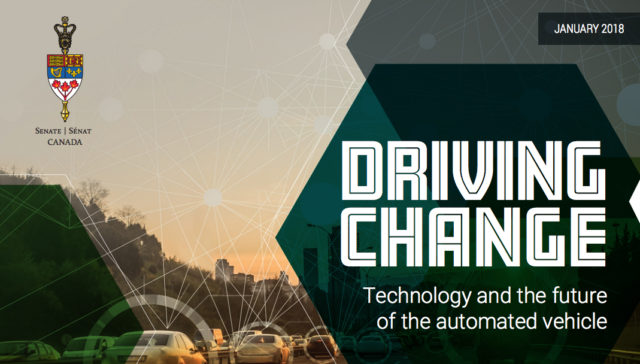A pivotal Canadian Senate Committee report on the coming new age of mobility reflects concerns expressed by the aftermarket.
The Standing Senate Committee on Transport and Communications has made 16 recommendations in all to prepare the country for a future with connected cars and autonomous mobility.
“These technologies will come with substantial benefits, not the least of which is safety,” says the report, Driving Change: Technology and the future of the automated vehicle. “With human error now causing the vast majority (about 94%) of traffic collisions, there is no doubt that automated and connected vehicles will save lives.
“However, these technologies also raise a number of concerns in terms of job losses, privacy, cybersecurity, urban sprawl and infrastructure. In particular, these vehicles collect a vast amount of data and could be the target of hackers who want to use the vehicles for nefarious purposes.”
For its part, the Automotive Industries Association of Canada, says key concerns expressed in May 2017 presentations were incorporated into the report.
On May 17, 2017, president Jean-François Champagne and vice president France Daviault of AIA Canada testified on behalf of the automotive aftermarket. They expressed concern for the increasing amount of vehicle data being generated by telematics technology and the control of that data by vehicle manufacturers. The report includes a section on ‘Data Access and Competition’ with recommendations for Innovation, Science and Economic Development (ISED) Canada “to monitor the impact of automated and connected vehicle technology on competition between the various sectors of the automotive and mobility industries, in order to ensure that sectors such as the aftermarket and car rental companies continue to have access to the data they need to offer their services.”
In addition to advocating for access to vehicle data, AIA Canada also asked the government to invest in the current and future workforce, ensuring that the sector is able and prepared to repair the vehicles of the future.
Included in this report are committee recommendations for “Economic and Social Development Canada to continue to work closely with the provinces and territories in order to strengthen retraining, skills upgrading and employment support for Canadians facing labour market disruption.”
The report is expected to serve as a cornerstone for policy makers into the future.
The recommendations cover key areas of concern, from policy, regulatory, and technology perspectives:
RECOMMENDATION 1:
Transport Canada and Innovation, Science and Economic Development Canada expeditiously create a joint policy unit to coordinate federal efforts and implement a national strategy on automated and connected vehicles.
RECOMMENDATION 2:
Transport Canada engage with provincial and territorial governments, through the Canadian Council of Motor Transport Administrators, to develop a model provincial policy for the use of automated and connected vehicles on public roads. The department should also involve municipalities in this engagement process.
RECOMMENDATION 3:
Transport Canada strengthen its work on automated and connected vehicles with the United States through the Regulatory Cooperation Council, to ensure that these vehicles will work seamlessly in both countries.
RECOMMENDATION 4:
Transport Canada urgently develop vehicle safety guidelines for the design of automated and connected vehicles. The guidelines should identify design aspects for industry to consider when developing, testing and deploying such vehicles on Canadian roads. The guidelines should also be updated regularly to keep pace with the evolution of automated and connected vehicle technology.
RECOMMENDATION 5:
Innovation, Science and Economic Development Canada allocate the 5.9 gigahertz spectrum that it has set aside for use in dedicated short-range communications systems, while continuing to reserve this spectrum for connected vehicle uses.
RECOMMENDATION 6:
Transport Canada, in cooperation with the Communications Security Establishment and Public Safety Canada, develop cybersecurity guidance for the transportation sector based on best practices and recognized cybersecurity principles. The guidance should include advice on original equipment, replacement equipment and software updates.
RECOMMENDATION 7:
Transport Canada work with Public Safety Canada, the Communications Security Establishment and industry stakeholders to address cybersecurity issues and to establish a real-time crisis connect network, and that Transport Canada report regularly on their progress.
RECOMMENDATION 8:
The Government of Canada table legislation to empower the Office of the Privacy Commissioner to proactively investigate and enforce industry compliance with the Personal Information Protection and Electronic Documents Act.
RECOMMENDATION 9:
The Government of Canada continue to assess the need for privacy regulations specific to the connected car.
RECOMMENDATION 10:
Transport Canada bring together relevant stakeholders – governments, automakers, and consumers – to develop a connected car framework, with privacy protection as one of its key drivers.
RECOMMENDATION 11:
Innovation, Science and Economic Development Canada monitor the impact of automated and connected vehicle technology on competition between the various sectors of the automotive and mobility industries, in order to ensure that sectors such as the aftermarket and car rental companies continue to have access to the data they need to offer their services.
RECOMMENDATION 12:
The Government of Canada increase its investments in the research and development of automated and connected vehicles, through a new Innovative and Intelligent Mobility Research and Test Centre, to be located at the existing Motor Vehicle Test Centre. In addition to ensuring that these vehicles are tested in a mix of urban, rural and cold environments, particular consideration should also be given to projects focused on cybersecurity and privacy.
RECOMMENDATION 13:
Innovation, Science and Economic Development Canada work with Networks of Centres of Excellence of Canada (NCE) to reconsider the rule requiring that these networks close down at the end of NCE program funding.
RECOMMENDATION 14:
Transport Canada monitor the impact of AV and CV technologies on automobile insurance, infrastructure and public transit in Canada.
RECOMMENDATION 15:
Employment and Social Development Canada continue to work closely with the provinces and territories in order to strengthen retraining, skills upgrading and employment support for Canadians facing labour market disruption.
RECOMMENDATION 16:
Public Safety Canada and the Communications Security Establishment work closely with the provinces and territories to develop cybersecurity training materials and programs to improve public understanding of cybersecurity issues.
The full report is available here.


0 Comments